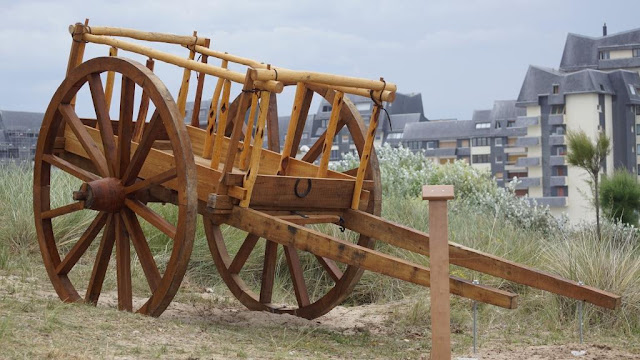![]() The Red River cart is a historical transportation device that played a significant role in the development of the Canadian West, particularly in the region of the Red River Colony, which encompassed parts of present-day Manitoba, North Dakota, and Minnesota. Here is a detailed account of the origins of the Red River cart:
The Red River cart is a historical transportation device that played a significant role in the development of the Canadian West, particularly in the region of the Red River Colony, which encompassed parts of present-day Manitoba, North Dakota, and Minnesota. Here is a detailed account of the origins of the Red River cart:
Origins and Design: The Red River cart was developed by the Métis people, who were of mixed European and Indigenous ancestry and were the primary inhabitants of the Red River region. The cart was uniquely suited to the terrain and conditions of the area, which consisted of vast open prairies, river valleys, and a lack of roads or established transportation infrastructure.
The design of the cart was simple yet ingenious. It consisted of two large wooden wheels, typically about five feet in diameter, connected by an axle made from a solid piece of wood. The body of the cart was a rectangular box made from wooden slats, with the front and back ends left open. The cart was entirely constructed using wooden pegs instead of nails or metal fasteners, as these were scarce commodities in the area.
The wheels of the Red River cart were distinctive and well-suited for traversing rough terrain. They had no spokes but were instead made from solid wooden disks with a convex shape. This design provided strength and stability, allowing the cart to bear heavy loads while minimizing the risk of wheel damage in uneven or rocky terrain.
Function and Importance: The Red River cart was primarily used as a means of transportation for trade and commerce. It was well-suited to carry heavy loads over long distances and could be pulled by a single horse or ox. The carts were commonly used to transport furs, goods, and supplies between the Red River Colony and distant trading posts, including those operated by the Hudson's Bay Company.
The carts played a crucial role in the economic development of the region. They facilitated trade between the settlers, fur traders, and Indigenous peoples, enabling the exchange of goods and resources. The cart's versatility allowed it to navigate through rough terrain, including prairies, river valleys, and even marshy areas, making it an invaluable mode of transportation in the region.
Impact and Legacy: The Red River cart had a profound impact on the settlement and growth of the Canadian West. Its durability and adaptability made it a vital tool for early pioneers and settlers in the region. The cart's design influenced subsequent developments in transportation, including the famous prairie schooners used in later years by settlers heading west during the North American westward expansion.
Although the Red River cart eventually fell out of use as technology advanced, its legacy remains an important part of Canadian history. It symbolizes the resourcefulness and ingenuity of the Métis people and their significant contributions to the development of Western Canada. Today, the Red River cart is recognized as an iconic symbol of the Red River Métis and is celebrated as an integral part of Canadian heritage and culture.
Source: Some or all of the content was generated using an AI language model


No comments:
Post a Comment